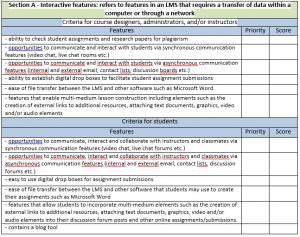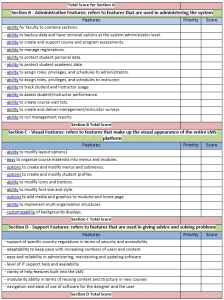This group project was a great experience. My group mates were keen to start the project promptly and we were quickly able to set a goal for our completion date that worked well for all three of us. We assigned roles and then conducted some research independently. We kept in steady communication with each other via email, google docs, and google hangouts too. It was a valuable learning experience in regard to both the research that I conducted for my portion of the framework analysis, as well as the contributions that were made by my fellow group members too. Here is a precis of our assigned scenario and the accompanying rubric and rationale.
Summary of our assigned scenario
You are an ad hoc committee made up of stakeholders at Athabasca University, one of the world’s leaders in distance-based learning. Competition for distance students at the undergraduate level in Canada (and the US) is increasingly competitive: to ensure sustainability in the long term, the Provost wants to market Athabasca programs overseas. South Asia, and its large English speaking population is to be a focus…but the reliability of internet connectivity can be a problem in the region. Thus the choice of delivery platform (specifically an LMS) is of critical importance.
Your team is tasked with developing an evaluation rubric to help the Provost to decide whether to keep the current LMS, select a new one, or perhaps run multiple systems. It should be noted that our research indicated that the current LMS used by Athabasca University at this time is Moodlle
Precis
In addition to the evaluation rubric seen below, the stakeholders and Provost at the university will need to take a number of other factors into consideration. Using a portion of the SECTIONS framework (Bates and Poole, 2003), we have also included information pertaining to the targeted student population, that being English speaking distance students in South Asia, that must also be considered by the university in making a decision about continuing with their current LMS, or selecting an entirely new system. We have expanded on both the ‘S’ for students and the ‘E’ for ease of use and reliability from the SECTIONS framework (Bates and Poole, 2003).
Students
In order to be increasingly competitive and to ensure sustainability in the long term, the student population that the committee of stakeholders at Athabasca University will be targeting is distance learners at the undergraduate level overseas, and in particular, those students that make up South Asia’s large English speaking population. Although a wide variety of languages are spoken by the inhabitants of this region, due to British colonial and ongoing commercial influences, English is considered to be this region’s main ‘link’ language (McArthur, 1998). The large number of English speaking individuals in the population can also be attributed to the fact that the government of India made English the official medium of education (McArthur, 1998). This target population is living in an area of the world in which both the interest in and the availability of online learning opportunities is growing at a rapid rate from kindergarten through to grade twelve, and in higher educational institutions as well. This explosive growth of online higher education enrolments in Asia can be shown by the following statistics: “One institution alone in China, ChinaEdu, has nearly 200,000 students taking degree programs wholly online, and over 100,000 South Koreans are enrolled in cyber universities” (Bates, 2012). Overseas students pursuing online education opportunities at the university level would likely be familiar with online learning platforms and would be an advantageous potential student population for Athabasca University to target for their online learning courses.
Ease of use and reliability
Regardless of the students’ familiarity (or unfamiliarity) with Learning Management Systems, the university will want to select a learning platform that will be easy for the students to use. Since the university has specifically chosen to target English speaking students, they do not need to ensure that the LMS they select has language options in addition to delivery of the course in English. The selected LMS will need to have straightforward navigation (be user friendly) and be fairly intuitive, so that students are not required to invest a huge amount of time learning how to use the platform and can instead concentrate on the actual course work. Technology requirements for the LMS will also need to be taken into consideration. Aspects such as which operating systems the LMS is compatible with and what other software applications may be required in order for the students to use all of the features of the platform, are important factors to take into account. The LMS that is selected must also meet the needs and skill levels of the course designers and instructors. Unless the university is prepared to take the time and spend the money necessary to train their distance education course designers and instructors on an entirely new LMS, they may want to consider keeping their current LMS or adopting a new system that is at least somewhat similar to the current platform used by the university.
Reliability in this particular case is a major potential concern. We know that internet connectivity in this region can be problematic, so this too will need to be carefully considered. A recent survey ranked “India, the biggest economy in South Asia, as having the slowest average internet connection speed, at 1.7 Mbps, in Asia-Pacific, less than half the global average of 3.9 Mbps” (De Guzman, 2014). In addition to the slow internet speeds, internet penetration into this region is also a concern as “only 12% of its population currently have access to the internet, almost three times lower than the global average of 35%” (De Guzman, 2014). Knowing the current internet and connectivity limitations of the targeted region, Athabasca University will need to thoroughly examine the potential Learning Management systems that are under consideration and place a high value on the systems best suited for these limited internet conditions.
LMS Evaluation Rubric for Athabasca University
To use this LMS evaluation tool, follow the steps below:
Step 1: The LMS Selection Committee will prioritize the various LMS features in the left hand column for each section by placing a number 1 through 5 in the “Priority” column next to its corresponding feature (1 = “not a priority”; 5 = “a necessity”).
Step 2: As the committee analyzes a particular LMS, they will assign the same number in the “Score” columns as the “Priority” columns, only if the LMS contains that particular feature. This weights the overall score of an LMS that has more features that the committee deems to be of high priority.
Step 3: Add up all of the scores for each section.
Step 4: Add all of the scores for each section together to give a final score. The LMS with the highest final scores will be examined in further detail in the next round of the evaluation.
To view the document in Microsoft Word, please use the link below.
LMS Evaluation Rubric for Athabasca University(1)-1
Rationale
We looked at a variety of different research articles in order to choose a path for selecting criteria to help the University decide which LMS would be the best choice for their expanding online overseas program. Our reference section includes our list of resources. We decided to focus on what we felt were the most relevant tools for choosing a LMS while considering the needs of both the administrators and the students. We examined in detail the following features: interactive, administrative, visual, support and technology. We chose not to include cost as one of our criteria as with any system there will be costs to consider. For example for proprietary systems, a big cost is paying the company for the software and support. For open- source systems there is still the cost to host, maintain and upgrade software as well as storage and database support and training of technical staff. We felt that once the University had used the rubric with a number of Learning Management Systems and the results were similar, the next step would then to be to consider cost to help them with the deciding factor.
References:
Almrashdeh, I, Sahari, N., Zin, N., Alsmadi, M. (2011). Distance learning management system requirements from student’s perspective. Journal of Theoretical and Applied Information Technology. Retrieved from
http://www.jatit.org/volumes/research-papers/Vol24No1/3Vol24No1.pdf
Bates, A.W. & Poole, G. (2003). Chapter 4: a Framework for Selecting and Using Technology. In Effective Teaching with Technology in Higher Education: Foundations for Success. (pp. 77-105). San Francisco: Jossey Bass Publishers.
Bates, T. (2012, November 18). Massive growth of online learning in Asia. Online Learning and Distance Education Resources. Retrieved from http://www.tonybates.ca/2012/11/18/massive-growth-of-online-learning-in-asia/
De Guzman, N. (2014, August 4). Internet access, security top policy concerns for South Asia. Asian-pacific Bureau. Retrieved from http://www.internetsociety.org/blog/asia-pacific-bureau/2014/08/internet-access-security-top-policy-concerns-south-asia
Foreman, S. (2013). Five steps to evaluate and select an lms: proven practices. Learning Solutions Magazine. Retrieved from:
http://www.learningsolutionsmag.com/articles/1181/five-steps-to-evaluate-and-select-an-lms-proven-practices
McArthur, T. (1998). “SOUTH ASIAN ENGLISH.” Concise Oxford Companion to the English Language. Retrieved September 21, 2014 from Encyclopedia.com: http://www.encyclopedia.com/doc/1O29-SOUTHASIANENGLISH.html
Panettieri, J. (2007). Addition by subtraction. University Business, August 58-62. Retrieved from http://www.universitybusiness.com/viewarticle.aspx?articleid=845
Weiss, C. (2012). E-learning 24/7 blog: the truth and realities of E-learning. Retrieved from
University of South Florida (2012).Teaching online: LMS evaluation checklist. Retrieved from http://teach.ucf.edu/resources/webcourses-migration/lms-evaluation-checklist/
Wright, C.R., Lopes V., Montgomerie C. T., Reju, S. A., Schmoller. S. (2014, April 21). EDUCAUSE Review. Retrieved from http://www.educause.edu/ero/article/selecting-learning-management-system-advice-academic-perspective



